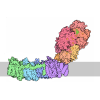[English] 日本語
 Yorodumi
Yorodumi- PDB-3eus: The crystal structure of the DNA binding protein from Silicibacte... -
+ Open data
Open data
- Basic information
Basic information
| Entry | Database: PDB / ID: 3eus | ||||||
|---|---|---|---|---|---|---|---|
| Title | The crystal structure of the DNA binding protein from Silicibacter pomeroyi | ||||||
 Components Components | DNA-binding protein | ||||||
 Keywords Keywords | DNA BINDING PROTEIN / STRUCTURAL GENOMICS / PSI2 / MCSG / Protein Structure Initiative / Midwest Center for Structural Genomics / DNA-binding | ||||||
| Function / homology |  Function and homology information Function and homology information | ||||||
| Biological species |  Silicibacter pomeroyi (bacteria) Silicibacter pomeroyi (bacteria) | ||||||
| Method |  X-RAY DIFFRACTION / X-RAY DIFFRACTION /  SYNCHROTRON / SYNCHROTRON /  SAD / Resolution: 1.8 Å SAD / Resolution: 1.8 Å | ||||||
 Authors Authors | Zhang, R. / Li, H. / Freeman, L. / Joachimiak, A. / Midwest Center for Structural Genomics (MCSG) | ||||||
 Citation Citation |  Journal: To be Published Journal: To be PublishedTitle: The crystal structure of the DNA binding protein from Silicibacter pomeroyi Authors: Zhang, R. / Li, H. / Freeman, L. / Joachimiak, A. | ||||||
| History |
|
- Structure visualization
Structure visualization
| Structure viewer | Molecule:  Molmil Molmil Jmol/JSmol Jmol/JSmol |
|---|
- Downloads & links
Downloads & links
- Download
Download
| PDBx/mmCIF format |  3eus.cif.gz 3eus.cif.gz | 44.8 KB | Display |  PDBx/mmCIF format PDBx/mmCIF format |
|---|---|---|---|---|
| PDB format |  pdb3eus.ent.gz pdb3eus.ent.gz | 32.6 KB | Display |  PDB format PDB format |
| PDBx/mmJSON format |  3eus.json.gz 3eus.json.gz | Tree view |  PDBx/mmJSON format PDBx/mmJSON format | |
| Others |  Other downloads Other downloads |
-Validation report
| Summary document |  3eus_validation.pdf.gz 3eus_validation.pdf.gz | 433 KB | Display |  wwPDB validaton report wwPDB validaton report |
|---|---|---|---|---|
| Full document |  3eus_full_validation.pdf.gz 3eus_full_validation.pdf.gz | 437.9 KB | Display | |
| Data in XML |  3eus_validation.xml.gz 3eus_validation.xml.gz | 9.5 KB | Display | |
| Data in CIF |  3eus_validation.cif.gz 3eus_validation.cif.gz | 12.5 KB | Display | |
| Arichive directory |  https://data.pdbj.org/pub/pdb/validation_reports/eu/3eus https://data.pdbj.org/pub/pdb/validation_reports/eu/3eus ftp://data.pdbj.org/pub/pdb/validation_reports/eu/3eus ftp://data.pdbj.org/pub/pdb/validation_reports/eu/3eus | HTTPS FTP |
-Related structure data
| Similar structure data | |
|---|---|
| Other databases |
- Links
Links
- Assembly
Assembly
| Deposited unit | 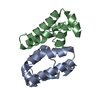
| ||||||||
|---|---|---|---|---|---|---|---|---|---|
| 1 |
| ||||||||
| Unit cell |
| ||||||||
| Details | This protein existed as dimer. The deposited MolA/MolB represent the dimer in the asymmetric unit. |
- Components
Components
| #1: Protein | Mass: 9699.137 Da / Num. of mol.: 2 Source method: isolated from a genetically manipulated source Source: (gene. exp.)  Silicibacter pomeroyi (bacteria) / Strain: DSS-3 / Gene: GI:56696110, SPO1217 / Plasmid: pMCSG7 / Production host: Silicibacter pomeroyi (bacteria) / Strain: DSS-3 / Gene: GI:56696110, SPO1217 / Plasmid: pMCSG7 / Production host:  #2: Water | ChemComp-HOH / | |
|---|
-Experimental details
-Experiment
| Experiment | Method:  X-RAY DIFFRACTION / Number of used crystals: 1 X-RAY DIFFRACTION / Number of used crystals: 1 |
|---|
- Sample preparation
Sample preparation
| Crystal | Density Matthews: 2.15 Å3/Da / Density % sol: 42.8 % |
|---|---|
| Crystal grow | Temperature: 289 K / Method: vapor diffusion, sitting drop / pH: 4.2 Details: 20% W/V PEG1000, 0.1M phosphate-citrate, 0.2M Li2SO4, pH 4.2, VAPOR DIFFUSION, SITTING DROP, temperature 289K |
-Data collection
| Diffraction | Mean temperature: 100 K |
|---|---|
| Diffraction source | Source:  SYNCHROTRON / Site: SYNCHROTRON / Site:  APS APS  / Beamline: 19-ID / Wavelength: 0.9794 Å / Beamline: 19-ID / Wavelength: 0.9794 Å |
| Detector | Type: ADSC QUANTUM 315 / Detector: CCD / Date: Dec 13, 2007 / Details: mirrors |
| Radiation | Monochromator: 0.9794 / Protocol: SINGLE WAVELENGTH / Monochromatic (M) / Laue (L): M / Scattering type: x-ray |
| Radiation wavelength | Wavelength: 0.9794 Å / Relative weight: 1 |
| Reflection | Resolution: 1.8→45.41 Å / Num. all: 15276 / Num. obs: 15172 / % possible obs: 99.32 % / Observed criterion σ(F): 2 / Observed criterion σ(I): 2 / Redundancy: 8.4 % / Biso Wilson estimate: 18 Å2 / Rmerge(I) obs: 0.06 / Net I/σ(I): 34.9 |
| Reflection shell | Resolution: 1.8→1.847 Å / Redundancy: 6.8 % / Rmerge(I) obs: 0.734 / Mean I/σ(I) obs: 1.36 / Num. unique all: 1168 / % possible all: 95.29 |
- Processing
Processing
| Software |
| |||||||||||||||||||||||||||||||||||||||||||||||||||||||||||||||||||||||||||||||||||||
|---|---|---|---|---|---|---|---|---|---|---|---|---|---|---|---|---|---|---|---|---|---|---|---|---|---|---|---|---|---|---|---|---|---|---|---|---|---|---|---|---|---|---|---|---|---|---|---|---|---|---|---|---|---|---|---|---|---|---|---|---|---|---|---|---|---|---|---|---|---|---|---|---|---|---|---|---|---|---|---|---|---|---|---|---|---|---|
| Refinement | Method to determine structure:  SAD / Resolution: 1.8→45.41 Å / Cor.coef. Fo:Fc: 0.956 / Cor.coef. Fo:Fc free: 0.936 / SU B: 6.947 / SU ML: 0.098 / TLS residual ADP flag: LIKELY RESIDUAL / Cross valid method: THROUGHOUT / σ(F): 0 / σ(I): 0 / ESU R: 0.139 / ESU R Free: 0.14 / Stereochemistry target values: MAXIMUM LIKELIHOOD / Details: HYDROGENS HAVE BEEN ADDED IN THE RIDING POSITIONS SAD / Resolution: 1.8→45.41 Å / Cor.coef. Fo:Fc: 0.956 / Cor.coef. Fo:Fc free: 0.936 / SU B: 6.947 / SU ML: 0.098 / TLS residual ADP flag: LIKELY RESIDUAL / Cross valid method: THROUGHOUT / σ(F): 0 / σ(I): 0 / ESU R: 0.139 / ESU R Free: 0.14 / Stereochemistry target values: MAXIMUM LIKELIHOOD / Details: HYDROGENS HAVE BEEN ADDED IN THE RIDING POSITIONS
| |||||||||||||||||||||||||||||||||||||||||||||||||||||||||||||||||||||||||||||||||||||
| Solvent computation | Ion probe radii: 0.8 Å / Shrinkage radii: 0.8 Å / VDW probe radii: 1.2 Å / Solvent model: MASK | |||||||||||||||||||||||||||||||||||||||||||||||||||||||||||||||||||||||||||||||||||||
| Displacement parameters | Biso mean: 17.854 Å2
| |||||||||||||||||||||||||||||||||||||||||||||||||||||||||||||||||||||||||||||||||||||
| Refinement step | Cycle: LAST / Resolution: 1.8→45.41 Å
| |||||||||||||||||||||||||||||||||||||||||||||||||||||||||||||||||||||||||||||||||||||
| Refine LS restraints |
| |||||||||||||||||||||||||||||||||||||||||||||||||||||||||||||||||||||||||||||||||||||
| LS refinement shell | Resolution: 1.8→1.847 Å / Total num. of bins used: 20
| |||||||||||||||||||||||||||||||||||||||||||||||||||||||||||||||||||||||||||||||||||||
| Refinement TLS params. | Method: refined / Origin x: 6.212 Å / Origin y: 40.995 Å / Origin z: 11.745 Å
| |||||||||||||||||||||||||||||||||||||||||||||||||||||||||||||||||||||||||||||||||||||
| Refinement TLS group |
|
 Movie
Movie Controller
Controller



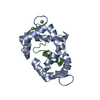




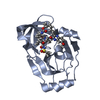
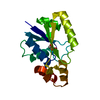

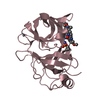
 PDBj
PDBj